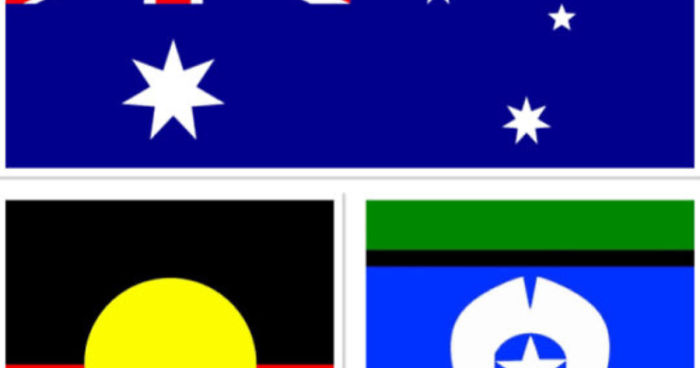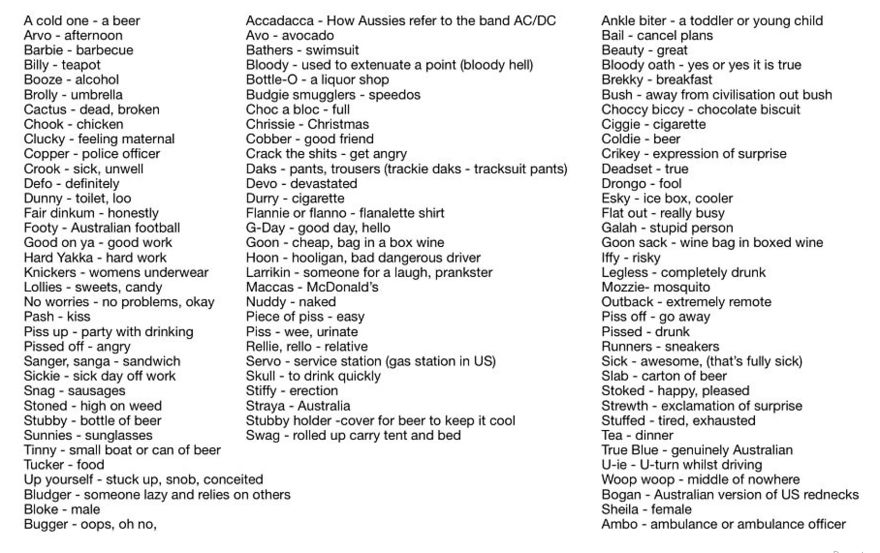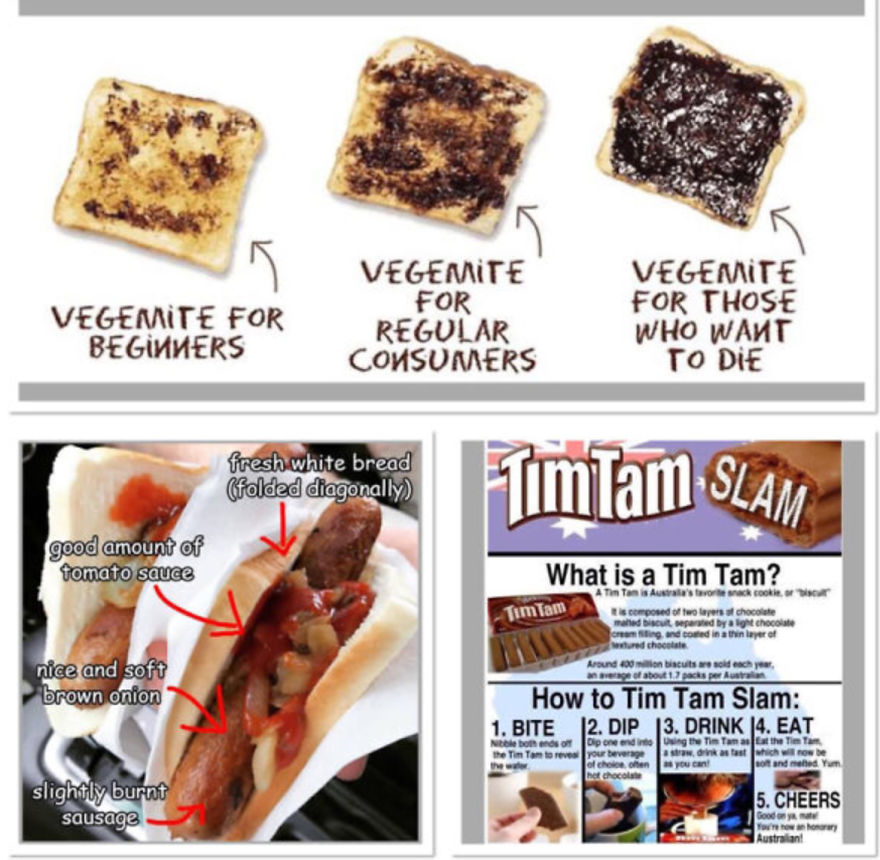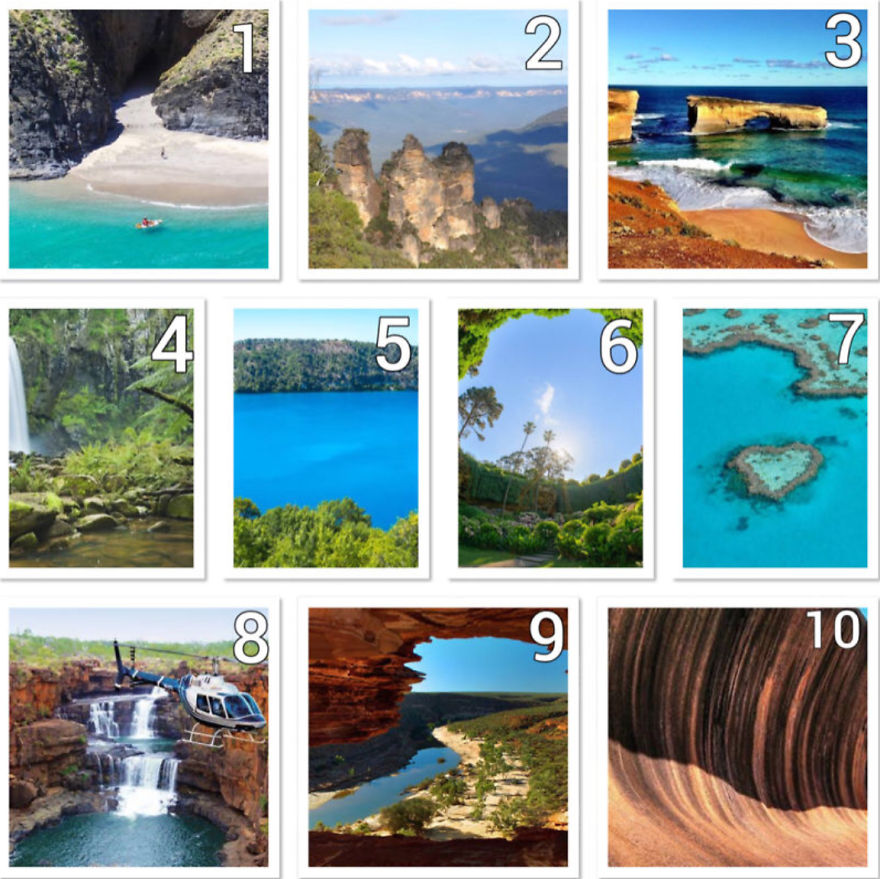Australia is a beautiful country from white sandy beaches to the red sandy desert. To the vast wine regions to the amazing people. Stunning wildlife and deadly ones too. We don’t ride emus or kangaroos, a drop bear won’t kill you (it’s just a koala) and we do not put “shrimps” on barbies, we call them prawns. We are seen as loud and laid back and don’t speak in full sentences (almost everything is abbreviated) and the word c**t is a common term of endearment between mates (friends). I want to share some of these things with you and I hope it will encourage you to come visit Australia.
Bring a plate, park ya bum and chillax while I take ya thru our awesome country!
This post may include affiliate links.
Australian vs. American, Lost In Translation
1. Thongs, yes thongs are a footwear in Australia. And what the US call thongs, we call g-strings. Can be a bit embarrassing going to the US to ask for thongs and be directed to the underwear section. 2. Squash, this is what Australians call squash. 3. These are all pumpkins in Australia whilst most are called squash in the US. 4. Biscuits, biscuits are cookies in the US and it can be so confusing. You know how gross it sounds hearing someone say biscuits with gravy. As an Australian I envision a choc chip biccy covered in gravy, ewww lol. 5. Bum bag, in the US this is called a fanny pack. Now in the US fanny means bottom but in Australia fanny means vagina. Hmmm awkward. 6. Cheese, now I know the US has cheese too but I just wanted to show the difference. Our regular cheddar cheese is yellow whilst in the US it is orange. Orange cheese just seems weird. 7. Coriander, is known as cilantro in the US. It seems to be a herb you either love or you hate. 8. Rockmelon, known as cantaloupe in the US.
Australia’s Dangerous Creatures
1. There are approx 1.5 shark related deaths a year. 2. More people are killed a year by the box jellyfish than snakes, spiders and crocodiles combined. 3. The Inland Taipan is the most venomous snake in the world but because it lives in sparcely populated areas there have been no recorded deaths. 4. The Sydney funnel web spider is the most venomous spider in Australia but many bites seem to have little serious effects on humans the most serious cases have resulted in death in as little as 15 minutes. 5. The Australian Magpie, whilst it has a beautiful song the males can be quite territorial during nesting season and will swoop passers by. There have been a few cases where the magpie has had contact with a person and gouged eyes or damaging eyes so bad the person is left with partial or complete vision loss. 6. The cone snail is highly toxic and can kill someone within minutes, fortunately there have only been a handful of recorded fatalities. 7. The stonefish is great at camouflage for any unsuspecting person to step on their toxic spines, luckily there is 1 unconfirmed death from a stonefish. 8. A 30g blue ringed octopus specimen has enough venom to kill 10 adults. There have been less than 5 deaths in the past century. 9. King brown snake is highly venomous and is often found in suburban areas. There is still only on average 2 deaths a year from snakes. 10. A male saltwater crocodile can grow to 4.3m - 5.2m (14ft - 17ft). There are on average 1 -2 croc fatalities a year.
I still feel like your whole damn country's wildlife will try to kill those who get too close
Aussie Food Icons
1. Iced coffee. Iced coffee is a sweet coffee flavoured milk. 2. Tomato sauce. Tomato sauce is like the US version of ketchup. It is a condiment used for everything from hot chips, sausages, hot dogs, chicken nuggets etc. 3. Meat pie. The meat pie is a hand sized pie that contains beef, onion and gravy and sometimes things like mushrooms, vegies etc. Best eaten with lots of tomato sauce or add the pie to pea soup for a pie floater. 4. Vegemite, good old classic vegemite. It is a yeast extract made from leftover brewers yeast and various vegetable and spice additives. It is strong in taste and that is why there is a right way and a wrong way to try vegemite. 5. Fairy bread. Fairy bread is a staple for kids birthday parties, it’s a piece of white bread, buttered and a sprinkling of hundreds and thousands (sprinkles). It is a great treat and even better if you use Nutella instead of butter. 6. Milo. Milo is a chocolate malt drink that can be drank hot or cold or it can be sprinkled on ice cream and breakfast cereals. Best way to have a cold Milo is 3-5 (or more) heaped tablespoons of Milo in a glass of milk. Best way to have a hot Milo is to do the Tim tam slam. 7. Lamingtons. Lamingtons are a soft spongy cake coated in a chocolate sauce and then covered in desiccated coconut. Sometimes there is jam in the middle. The most popular time of the year for lamingtons to be bought and eaten is Australia Day.
Common Aussie Slang
Indigenous Australians
1. Witchetty grub, Witchetty grubs are part of the traditional diet of indigenous Australians. Witchetty grubs are eaten either raw or cooked and are very high in protein and have a nutty flavour. They have been said to taste like scrambled eggs, and when cooked they taste like chicken. 2. Spear and woomera, A woomera is a wooden spear throwing device. It serves as an extension of the human arm, enabling a spear to travel at a greater speed and force than possible with only the arm. And spears were used for hunting. 3. Didgeridoo, the didgeridoo is an instrument developed by indigenous Australians traditionally used in ceremonies. The name Didgeridoo is a western name but is called other names with each different indigenous tribe. 4. Dot paintings, Traditional aboriginal dot paintings represent a story, generally regarding hunting or food gathering and usually have traditional aboriginal symbols imbedded throughout the painting. These symbols, when explained, give a completely whole new meaning to the painting. 5. Rock paintings, There is no written language for Australian Aboriginal People so in order to convey their important cultural stories through the generations it is portrayed by symbols/icons through their artwork. The oldest firmly dated rock art painting in Australia is a charcoal drawing on a rock fragment found during an excavation in the Northern Territory. Dated at 28,000 years, it is one of the oldest known pieces of rock art on Earth with a confirmed date. 6. Boomerang, Boomerangs were used in hunting and wars. Most boomerangs don’t come back and were never intended to do so. The returning variety are thought to have evolved as a special form.
How To Eat Iconic Aussie Foods, The Right Way
Vegemite One common mistake us Australians see by internationals trying vegemite, is HOW they try it. You do not put a spoon in the jar and eat it off the spoon. Most Australians wouldn’t even do that. Step 1. Have some fresh toast made and add you butter, most people like a LOT of butter. Step 2. Put a small amount of vegemite on your knife and give a light scrape of the knife over the toast. Step 3. Then taste. If you like it and are willing to try more vegemite just start slow and add more until you get the taste of your liking. I am in between vegemite for beginners and for regular consumers.
Sausage sizzle Going to Bunnings (hardware store) and getting a snag (sausage) is a rite of passage for most Australians. It’s so easy and tastes great. You need good old snags (sausages, NOT hotdogs), white bread, onion and sauce. Place the sausage on your bread diagonally, add onions and tomato sauce, then fold the bread and eat. Yummo.
Tim tam slam A Tim tam is a chocolate biscuit you use as a straw to suck up a hot or cold beverage. Hot chocolate or hot milo is best for this. You bite one corner of each end of the Tim tam, dip it into your drink and suck like you would a straw. Don’t leave it for too long coz the biscuit will fall apart in your drink but it tastes amazing especially when the biccy goes gooey from the hot drink. Mmmmm
Random Facts About Australia
1. Australia is the 6th largest country by size. 2. Australia is the only country that is also a continent. 3. Australia is the smallest of the world's continents. It is also the lowest, the flattest and (apart from Antarctica) the driest 4. The population of Australia is approx 25.09 million. 5. A single cattle ranch is South Australia is larger than the state of Israel. 6. The area of Australia that is covered by snow in winter, is larger than the area of Switzerland. 7. Australia has the longest fence in the world and runs over 5,530 kilometres (just over 3,436 miles). 8. The worlds longes golf course is more than 1367 kilometres long (850 miles) and is in Australia. 9. Australia has the steepest passenger railway. At a 52 degree incline (128% incline) it descends 310 metres through a cliff side tunnel then emerges into rainforest. 10. Australia is home to 10 of the worlds 15 most venomous snakes as well a a disproportionate number of venomous spiders. 11. Over 1 million wild camels roam the Australian desert. They were introduced to help with railway construction. Saudi Arabia imports camels from Australia (mostly for meat product). 12. Aboriginal culture is the oldest on earth a genetic study has found, confirming they may have the oldest continuous culture on the planet 13. The largest Greek population besides Athens in Greece can be found in Melbourne Victoria. 14. The bunyip is a mythical creature from Aboriginal mythology. It is said to lurk in swamps, billabongs, waterholes etc. 15. The UK has 248.25 person per square km, Australia only has 2.66. 16. Australia is one of the only countries where we eat the animals on our coat of arms. 17. If you visited one new beach in Australia every day, it would take over 27 years to see them all. 18. The Great Barrier Reef is the largest living organism in the world (sadly it is slowly dying from climate change). 19. A large proportion of Australians don’t even know the full second verse of our national anthem let alone the whole thing and the histor behind it. 20. The male lyre bird, which is native to Australia, can mimic the calls of 20 other birds. He can also perfectly imitate the sound of a chainsaw, camera and car alarm. 21. In 1979 NASA was fined $400 for littering when debris from ‘Skylab’ crashed into Esperance WA. 22. 40% of Australia in uninhabitable as it is too hot in the middle of the desert. 23. Most of Australia’s exotic flora and fauna cannot be found anywhere else in the world. 24. Eucalypt trees light themselves on fire, which helps the land regenerate. 25. Australia is the only continent without an active volcano.
Home Of The “Big” Things
For some reason Australia has a fascination with “Big” things. 1. The Big Merino is located Goulburn NSW it stands 15.2 meters high, 18 meters long. 2. The Big Lobster is located Kingston SE, SA. It stands 17 metres high. 3. The Big rocking horse is located Gamuracha SA it stands over 18 metres tall and for $2 you can climb it and receive a certificate. 4. The Big pineapple is located Woombye QLD it stands 16metres high. 5. The Big prawn is located Ballina NSW it stands 9 metres high. 6. The Big banana is located Coffs Harbour NSW it is 12metres long and was one of the first “big” things in Australia.
There are estimated to be over 150 such objects around the country.
Australian Inventions
1. Electric drill. The electric drill was invented in Melbourne VIC in 1889. 2. The black box. The flight reorder was invented in Melbourne VIC in 1953. 3. Electronic pacemaker. The lifesaver was invented in Sydney NSW in 1926. 4. Cochlear implant. The first cochlear implant surgery was done in 1978. 5. Inflatable escape slide. The inflatable slide was invented in 1954 and the same inventor created the inflatable escape raft. 6. Ugg boots. The ugg boot style was worn in the 1920s by shearer’s but the name Ugg didn’t come about until around 1960. 7. Wi-fi. Wi-Fi was released to consumers in 1997. Too bad that internet service in Australia is SHOCKING and really slow. 8. Hills hoist. This rotary clothesline was invented in 1945 and is found in many backyards around Australia.
I find it ironic that we invented wifi yet we have one of the worst internet service and one of the most expensive.
“National Anthem” Of Australia (Not Really, But It Should Be Lol)
I would vote for that to be our anthem or I am Australian. We are one, but we are many. And from all the land on earth we come. We’ll share a dream, and sing with one voice. I am, you are, we are Australian.
Australian Native Animals
1. Cassowary. The Cassowary is supposedly the worlds most dangerous bird, it’s talons can disembowel a human. But they are shy and solitary so attacks aren’t common. 2. Kookaburra. The kookaburra is part of the kingfisher family that has a very distinct sound, it sounds as though it is laughing at you. 3. Platypus. Is it a duck? Is it a beaver? No, it’s a platypus. A platypus is 1 of the only 2 mammals in the world that lays eggs and is known as a monotreme. The males have hollow spur on each hind leg which produces venom during mating season. 4. Common brush tail possum. It is the most often seen Australian marsupial by city dwellers, as it is one of few that thrive in cities and a wide range of natural and human-modified environments. 5. Echidna. The Echidna is the other mammal that lays eggs (monotreme). Whilst echidnas eat ants and termites like other ant eaters, they are not closely related. 6. Kangaroo. The biggest kangaroo species is the red kangaroo, it can weigh 90kg and reach 2 metres tall. 7. Wombat. Wombats dig burrows with their rodent-like front teeth and powerful claws. The wombat has a backward facing pouch and the advantage is that when digging the wombat doesn’t get soil in the pouch. Wombats are the only animals who poop in cube shapes. 8. Quokka. The quokka has little fear of humans and it is common for quokkas to approach people closely, particularly on Rottnest Island where there is a prevalent population of them. Even though quokkas have a reputation of the happiest animal on Earth, there a few dozen cases annually of quokkas biting people. 9. Koala aka drop bear. Koalas sleep for approx 20 hours a day and the rest of the time is mainly eating. The male koala mating call is far worse than a snoring partner. And they do not drop from trees on unsuspecting people to attack.
Did you know that if Quokkas are threatened they will throw their babies as a distraction to run away.
Some Incredible Places To Check Out
1. Twelve apostles, Great ocean rd VIC. It is unknown how the name twelve apostles came about especially since there were originally only 8 rock structures grouped together. One has since collapsed so 7 remain. 2. Sydney opera house, Bennelong point SYD. There are over 40 shows a week held at the opera house and 10.9 million people visit annually. 3. Uluru, NT. Uluru is aka Ayers Rock. It holds special cultural significance to the Anungu people and it is deemed disrespectful to climb the rock. But by all means take a walk around Uluru. It should take you about 3.5 hours. 4. The Simpson desert, NT, SA and QLD. The Simpson desert is a largely uninhabited arid region covering some 55,000 square miles (143,000 square km). It is one of the last refuges for some of our rare desert animals. 5. Freycinet National Park, TAS. This is one of Australia’s oldest nature reserves and is home to pink granite peaks. 6. Kakadu, Jabiru NT. More than half the park is Aboriginal land, and all of Kakadu is special to its traditional owners. Kakadu’s traditional owners manage the park in partnership with Parks Australia 7. Sydney harbour bridge, Sydney NSW. The bridge is nicknamed the coat hanger because of its arch design. Over 4 million people have climbed the harbour bridge. 8. Tasman national park, Cape Raoul TAS. The Blowhole and Tasman Arch are two of the park's most famous features. Other top sites include Remarkable Cave, Waterfall Bay, and the Devil's Kitchen, a collapsed rock arch. 9. Bungle bungles, Purnululu WA. The bungle bungle range has long been inhabited by local Aboriginal people, but did not become widely known to the rest of the world until the mid 1980s. 10. Pink Lake, Esperance WA. Pink Lake (previously known as Lake Spencer) is a salt lake. Although historically the water in the lake was visibly pink, as of 2017 it had not been pink for over ten years 11. Devils marbles, Warumungu NT. Aka Karlu Karlu. the rocks vary in size, from 50 cm up to six metres across, and they are strewn across a large area. Many of them seem impossibly balanced on top of each other.
Australia’s Deadliest Animals Song (Warning- Contains Strong Language Which May Be Offensive)
This is absolutely brilliant, and funny. I have to show my family this.
More Stunning Places Australia Has To Offer
1. Rapid Bay S.A, one of the very few places leafy sea dragons are found in the world. They are classified as near threatened. 2. The three sisters, Blue mountains NSW, Common legend is three sisters were turned to stone. You should google it. 3. London bridge, Great ocean rd VIC. 2 people got stranded on the other side when the rock collapsed, it took 3 hours for them to be lifted to safety. 4. Daintree rainforest, QLD It is the oldest continually surviving tropical rainforest in the world. 5. Blue Lake, Mount Gambier SA. The Blue Lake occupies one of the craters of an extinct volcano. 6. Umpherston sinkhole, Mount Gambier SA. This sinkhole was turned into a garden in 1886 by James Umpherston and is now a tourist attraction. 7. The Whitsunday Islands, QLD. The Whitsundays are a group of 74 small islands that sit right in the heart of the Great Barrier Reef, The biggest living organism in the world. 8. Kimberley’s, WA. The Kimberley’s is 3 times the size of England. 9. Natures window, WA. Natures windows is a naturally made rock arch caused by wind erosion. 10. Wave rock, Hyden WA. The rock is shaped like a wave and is about 15 m (49 ft) high and around 110 m (360 ft) long.
Love it! I'm forwarding the whole list to my Australian DIL.
This would have to be one of my favourite posts. I learnt so many new things about our country, thank you. Aussie, Aussie, Aussie. Oi, Oi, Oi.
Love it! I'm forwarding the whole list to my Australian DIL.
This would have to be one of my favourite posts. I learnt so many new things about our country, thank you. Aussie, Aussie, Aussie. Oi, Oi, Oi.

 Dark Mode
Dark Mode 

 No fees, cancel anytime
No fees, cancel anytime 


















































































